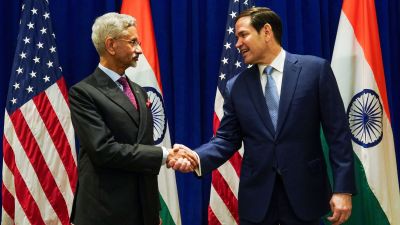Exactly three years ago, Japanese Prime Minister Shinzo Abe had flown down to Kyoto, one of Japan’s historic cities, and welcomed Prime Minister Narendra Modi in what was his first bilateral visit outside India’s immediate neighbourhood within four months of assuming office.
Now, Modi will be returning the favour and welcoming Abe in poll-bound Gujarat on Wednesday. He is likely to go to the airport to receive him — a departure from protocol he has made only for a handful of leaders, including US President Barack Obama.

Sources said Modi would then take Abe on a “massive roadshow” — from the airport to Sabarmati Ashram, possibly in an “open-top limousine” — with people cheering for them. There are plans of having schoolchildren lined up on the route, along with tableaux of 28 states.
Story continues below this ad
The road from the airport to the city has been dotted with hoardings with photos of Abe and Modi, as well as cutouts, declaring “a strong synergy for peace and prosperity”, “welcome to the only home of Asiatic lions”, “New India, bright future”, and of course, “Welcome to India, welcome to Gujarat” — in Japanese Hiragana script.
After touring Sabarmati Ashram, the two leaders will meet again and visit a 16th-century mosque — Sidi Sayyaid ki Jaali. Then they will engage in “dinner diplomacy” at one of Ahmedabad’s top-rated restaurants serving authentic local cuisine — similar to what Abe had done for Modi at Kyoto’s state guest house in 2014.
Also read | Shinzo Abe visit: Stop at Mughal era mosque in Modi-Abe roadshow highlight
After dinner, the two leaders are planning to go for a walk on a more than 100-year-old bridge, the Ellis bridge on the Sabarmati, which has been decorated with colourful fairy lights. “The roadshow, airport reception, dinner at a roof-top restaurant, and post-dinner walk — they will all send out pictures of warmth between the two leaders. Optics apart, it will give the two leaders ample time to engage with each other for almost eight hours on the first day of the visit,” a top source involved in the arrangements told The Indian Express.
Story continues below this ad
In a massive operation to broadcast the images, about 100 cameras — 40 for the roadshow alone — along with more than 300 personnel have been deputed by Doordarshan to capture every moment between the two leaders over two days. Both sides have carefully chosen “photo opportunities” that are different from those in 2014 when Chinese President Xi Jinping visited Ahmedabad. “We wanted different locations so that there are no similarities, since the relationships with both countries are at completely different levels,” the source said.
Just weeks ago, India and China resolved a 10-week-long border standoff at Doklam. Japan was the only major country to publicly articulate its unequivocal support to India during the border crisis.
India and Japan are likely to beef up strategic partnership in the neighbourhood in terms of joint development of projects, sources told The Indian Express. This comes with an eye on China’s attempt to increase its strategic footprint in the region, which has both Tokyo and Delhi worried. Abe’s visit is likely to witness a more pronounced articulation of countering the Chinese sphere of influence.
Darshana M Baruah, research analyst at Carnegie India who has worked on the subject, said, “Neither India nor Japan are shy of the strategic connotation in their expanding partnership which signifies great comfort and trust in the relationship. China’s expansion… has caused much concern and discomfort in Delhi… Japan on the other hand has a policy on ‘Free and Open Indo-Pacific Strategy’ with India at its centre.” The India-Japan partnership is getting “stronger and bolder” and at the crux of this relationship is the drive to boost connectivity, she added.
Story continues below this ad
On Thursday, the two leaders will have bilateral talks at Mahatma Mandir in Gandhinagar. Before that they will address a public meeting after the ground-breaking ceremony for the bullet train project between Ahmedabad and Mumbai.

 Preparations at the restaurant where PM Narendra Modi and his Japanese counterpart will have dinner on Wednesday. (Express Photo: Javed Raja)
Preparations at the restaurant where PM Narendra Modi and his Japanese counterpart will have dinner on Wednesday. (Express Photo: Javed Raja)






